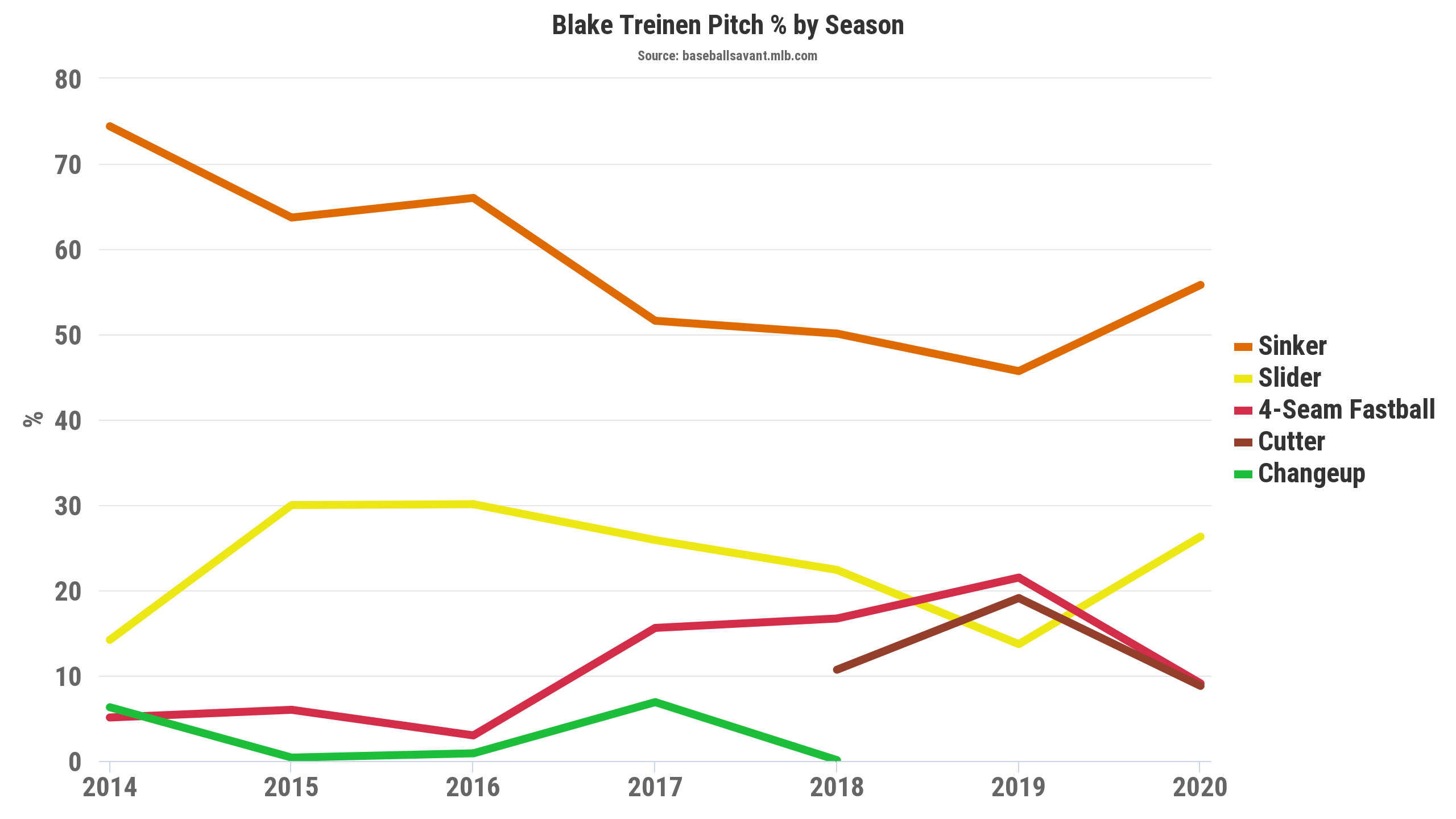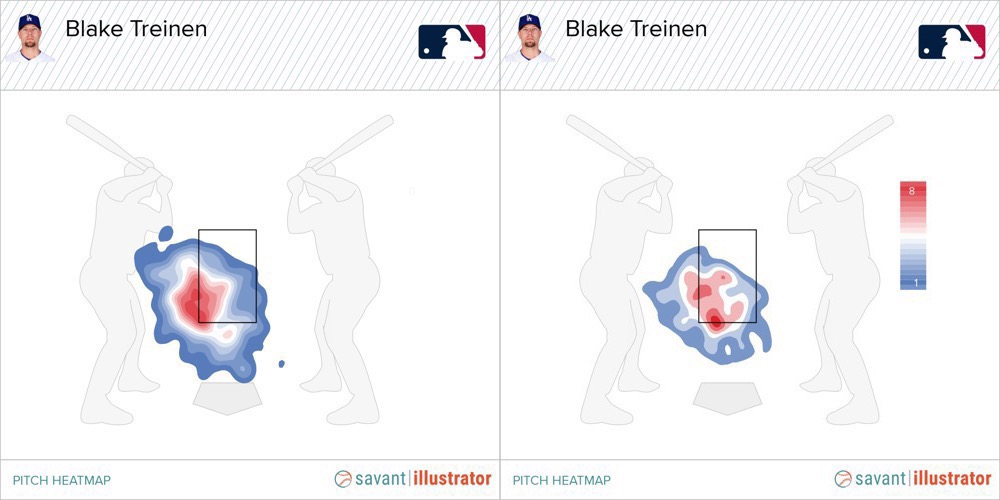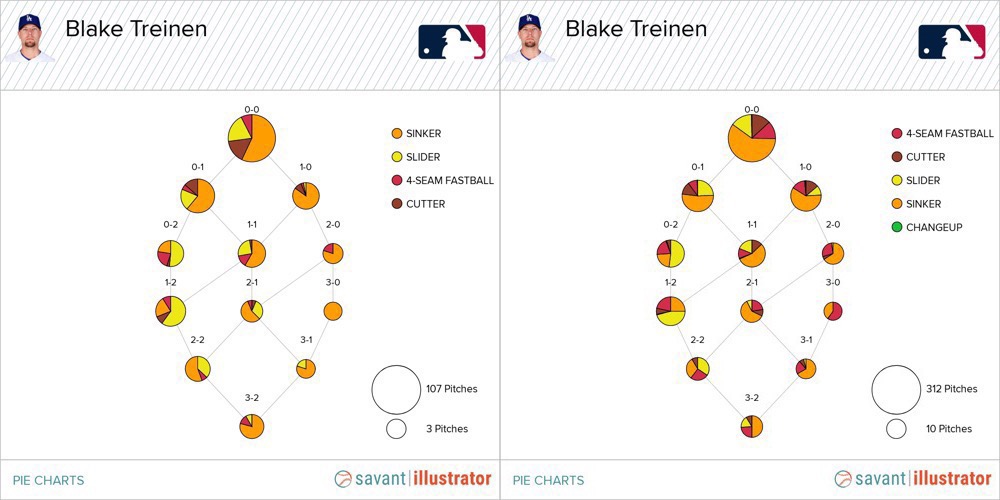How Blake Treinen Reinvented Himself
Earlier this month, Blake Treinen returned to the Dodgers on a two-year, $17.5 million deal. Treinen was non-tendered by the Athletics after a down season in 2019 before signing a one-year, $10 million deal with Los Angeles that led to a decent bounceback in 2020.
While the Dodgers were also reportedly interested in adding Liam Hendriks, now a White Sox, the fact that they eventually signed Treinen to a multi-year deal suggests that they were looking closely at his performance in 2020. However, from looking at various data and video, Treinen in 2020 appears to be a particularly different pitcher than Treinen in 2018.

I’d like to take a closer look at how Treinen has changed since his time with the A’s. The first thing to note about his performance after joining the Dodgers is that his groundball rate was 65.3%, up more than 20 points from 45.0% the year before. This is more than 10% higher than in 2018, when he had the best performance of his career. Meanwhile, his strikeout rate was 20.6%, the lowest since his debut in 2015 and well under his career high of 31.7% in 2018. These numbers lead me to believe that Treinen’s change in pitching style is intentional.
While it is undoubtedly preferable to get plenty of grounders and strikeouts, very few pitchers are great at both. Below is a scatter plot I made of GB% and K% for pitchers in 2020, and the two metrics were surprisingly uncorrelated. That’s how difficult it is to reconcile these two abilities.

Treinen is no exception. The first thing to note about his changes is that his sinker and slider pitch percentages are on the rise; according to Baseball Savant, his sinker percentage is up 10% (from 45.7% to 55.8%) in 2019. Similarly, his slider usage has increased from 13.7% to 26.3%. On the other hand, the cutter and four-seamer have been used less.

The next graph I want to show you is the pitch ratio by pitch count; the left side is for 2020 and the right is 2018 (with the A’s). We can visualize the increase of sinkers and sliders in each count, just as the ratio of sinkers and sliders has increased overall.
More interesting, however, is the change in pitch selection with two strikes — specifically, that he is throwing more sinkers in 2-2 and 3-2 counts, and that he didn’t throw cutters at all in those situations. This certainly feels like a change in approach, especially when it comes to his sinker.
Let’s look at how Treinen has changed his sinker usage since joining the Dodgers. Here are some heatmaps for the pitch, with 2019 on the left and 2020 on the right.

It sure looks like the sinker is being thrown more inside the strike zone in 2020, and the metrics agree, with the pitch’s ZONE% increasing from 41.8% to 50.7%. What intention is there behind this change? I think his goal is to induce weak contact and get more groundballs, which was indeed the result.
While more groundballs is obviously good, it may be too simplistic to think that just throwing more sinkers into the strike zone has led to Treinen’s resurgence. This is especially true when you consider the launch angle revolution. The sinker is a great pitch for hitters to angle upwards because it tends to collect in the low part of the strike zone, which has made life difficult lately for some pitchers who rely on it. As a countermeasure, the four-seam fastball has received a lot of attention, which is high and difficult for hitters to angle.
However, Treinen has still been successful throwing his sinker in the zone, and the surprising key to that has been the use of his cutter. He used to throw it in just about all counts, and in 2019, he used it as a decisive pitch at a higher rate than his slider. But here are his latest cutter heatmaps, with 2020 on the left and 2019 on the right.

We can see that Treinen is throwing his cutter higher in the zone in 2020, in addition to him using it earlier in counts (instead of at 2-2 or 3-2).
The combination of a low sinker and a high cutter has the effect of changing the batter’s line of sight. The cutter early in the count is drawing the batter’s eye, creating a high-low difference with sinker at the bottom of the zone. In other words, Treinen has changed the cutter from a decisive pitch to a complementary pitch that makes the sinker stand out.
It’s interesting to see how Blake Treinen’s increase in groundballs is just as much a result of how he uses his cutter as his sinker, which I assume the Dodgers knew very well when they gave him a new multi-year contract.
Thank you for reading. I am on Twitter @yomimono_eng.


This is a good, deeper dive on a guy I’m excited to see pitch for LA. Thanks 🙂
Treinen was non-tendered by the Athletics after a down season in 2019 before signing a one-year, $10 million deal with Los Angeles that led to a decent bounceback in 2020 https://www.mycardstatement.review/